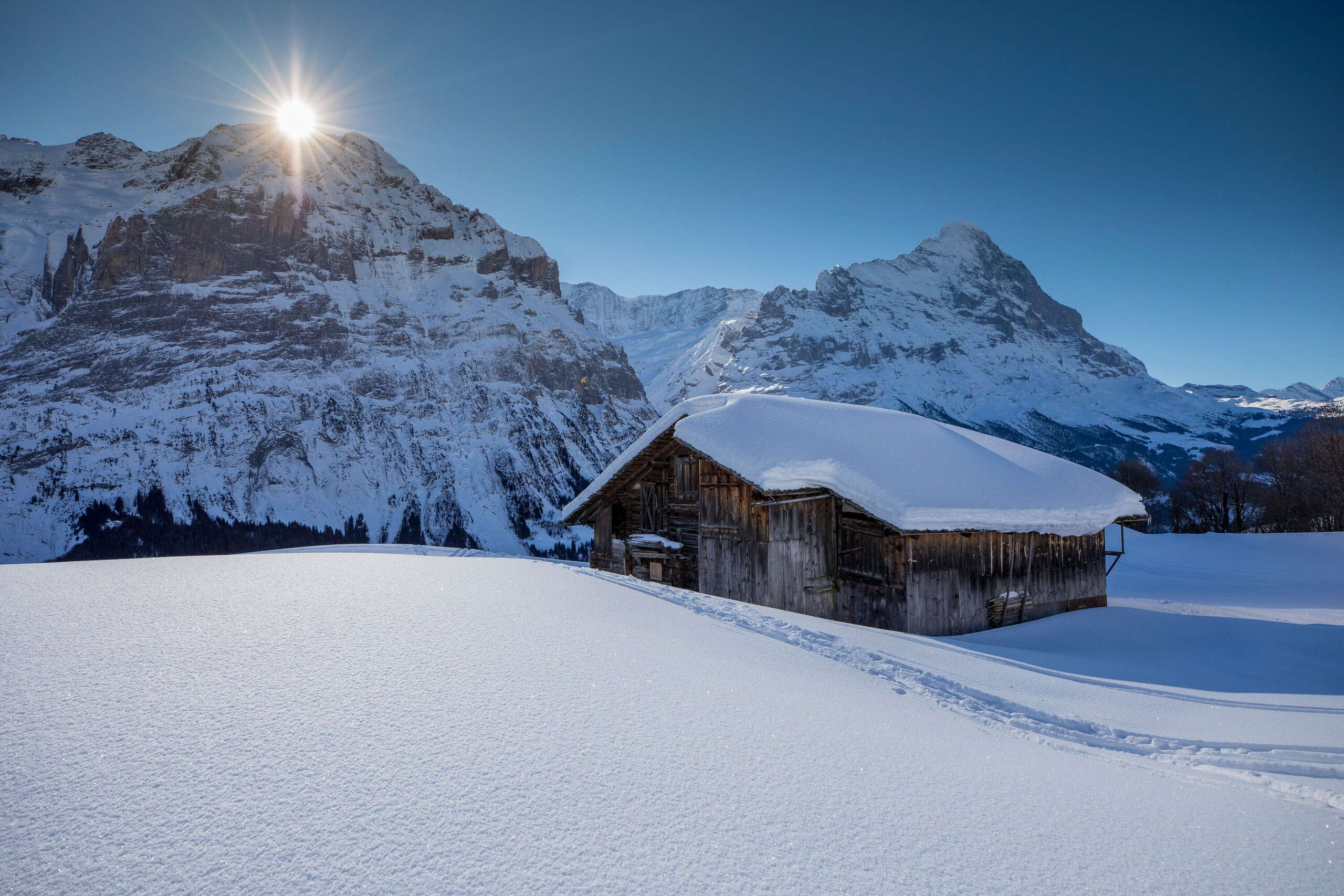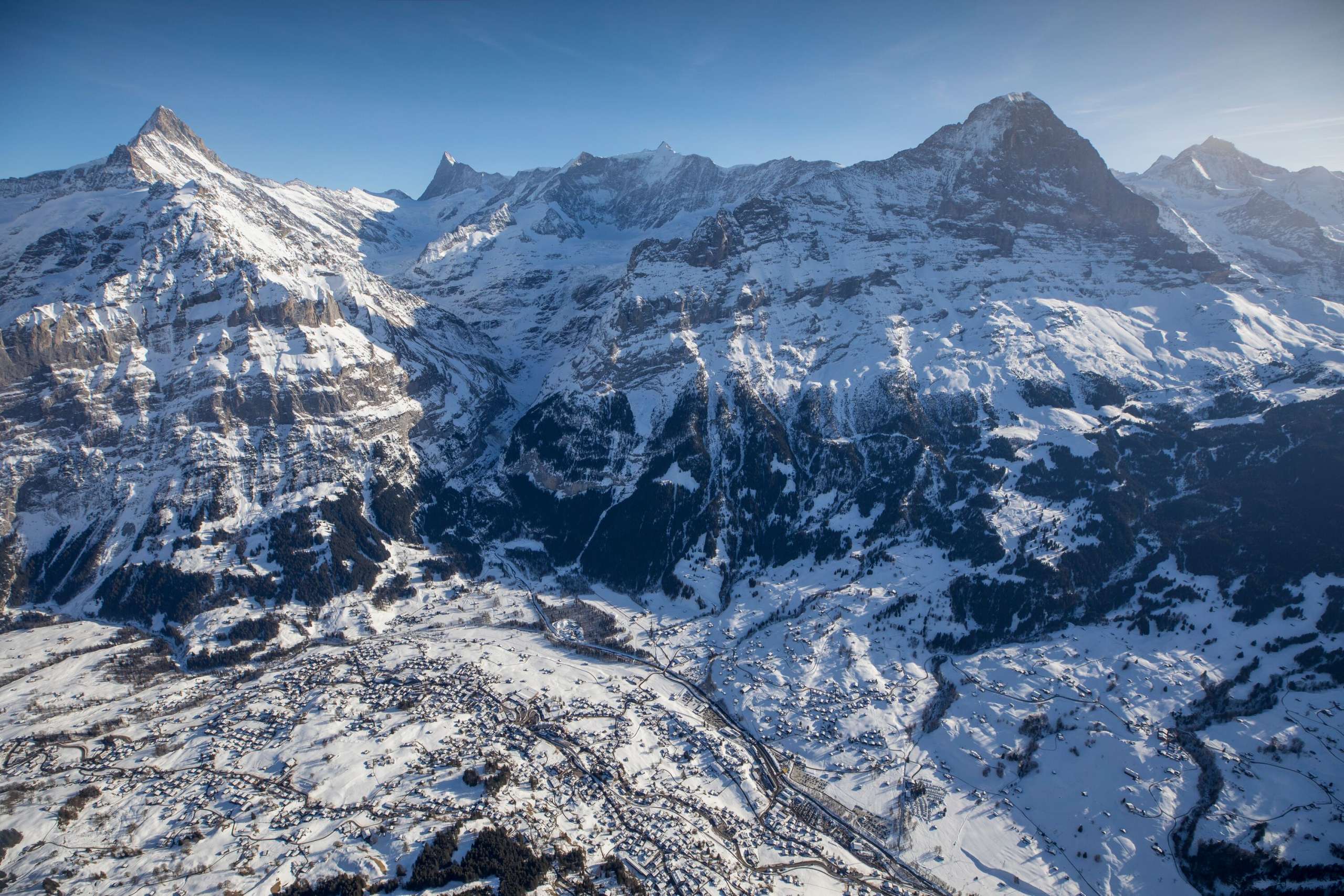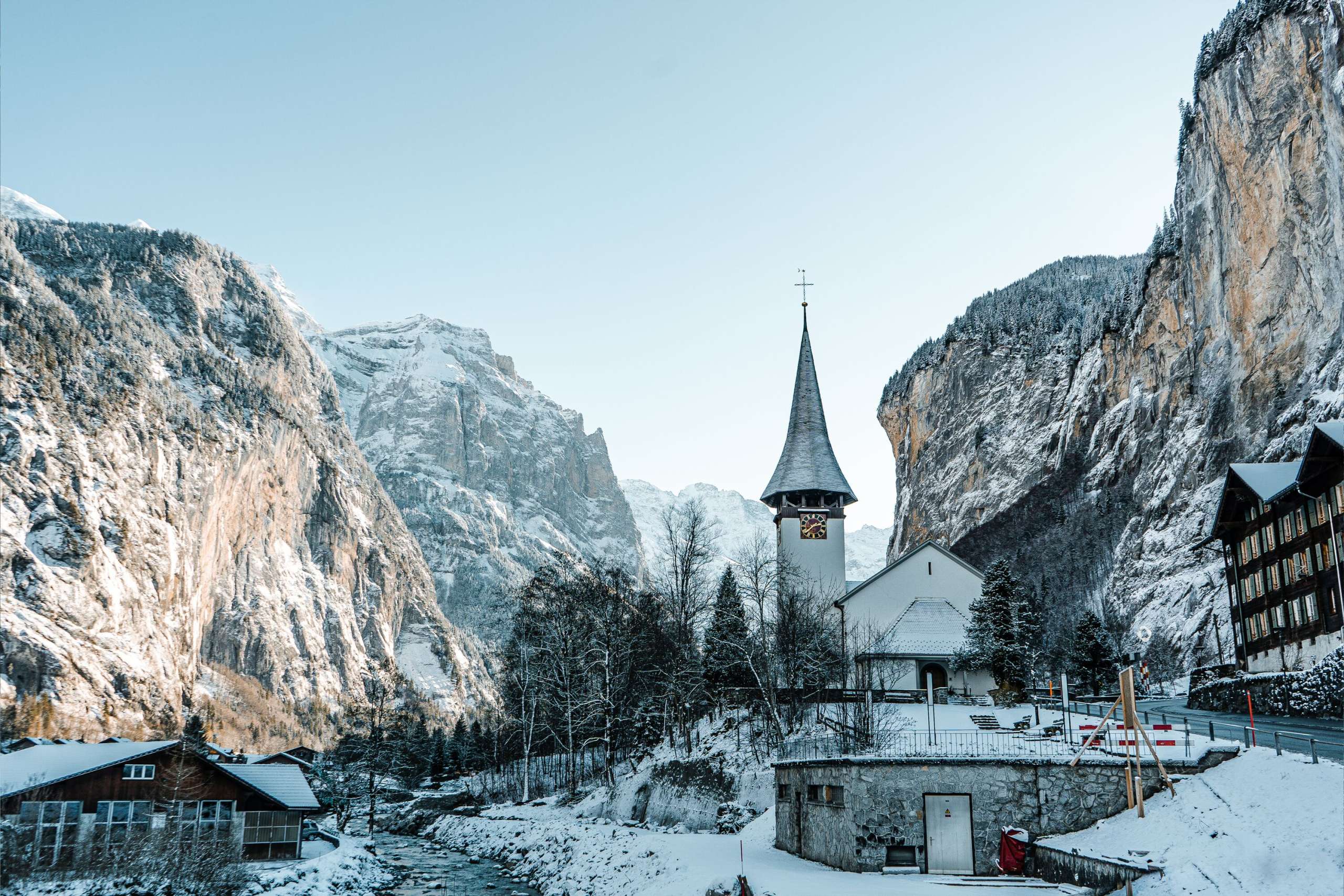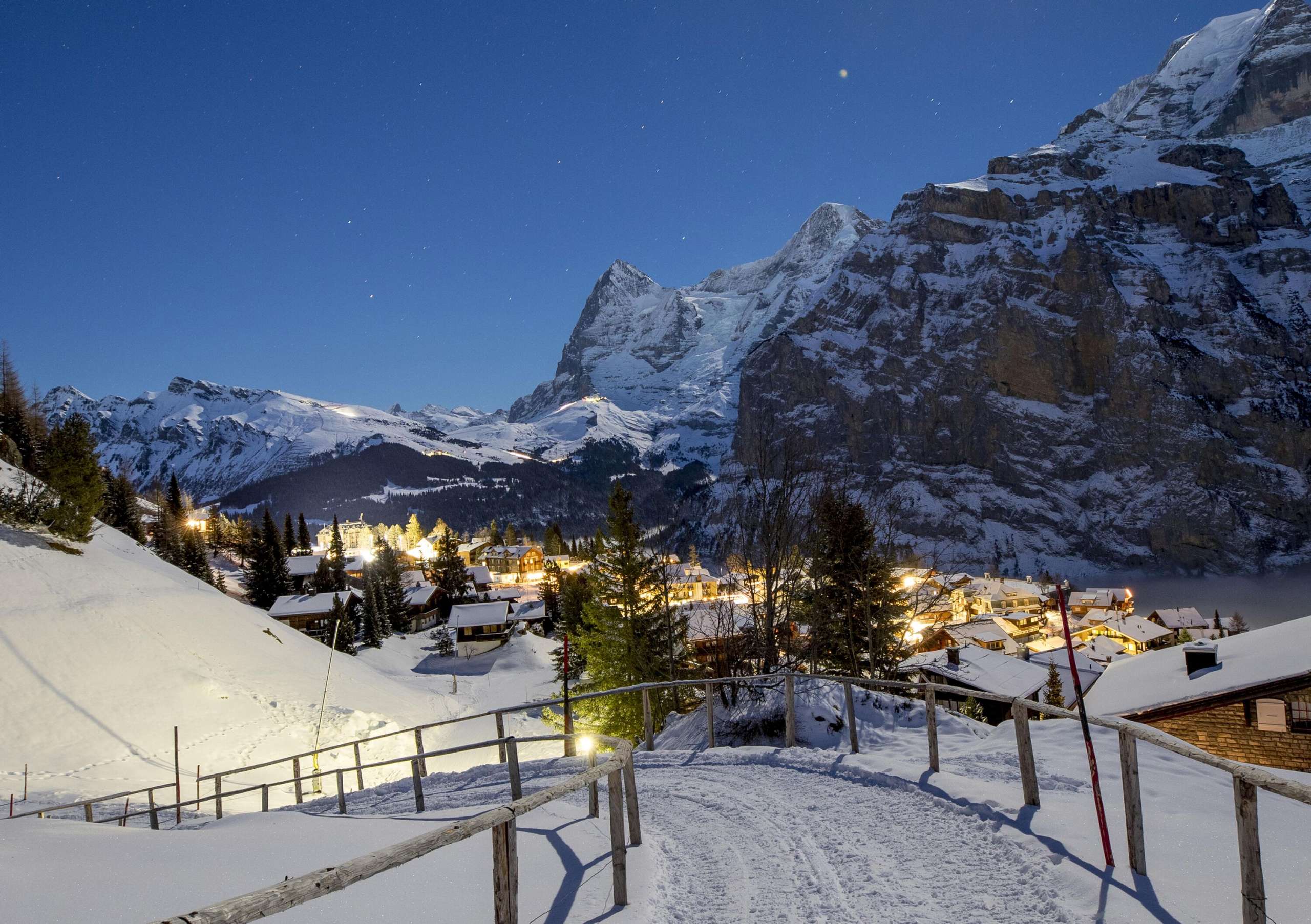Jungfrau Region – unique. diverse.
Whether hiking or biking. Whether on the piste, the cross-country ski trail or in the ice rink. Whether on a mountain peak or in a museum. Whether skiing, curling, cross-country skiing or on a snowshoe tour. Whether for the eyes or the palate. Total relaxation or pure adrenalin. For children or adults. During the day or at night. No matter what time of day. In fine weather or when it's raining and storming. And whether in Grindelwald, Wengen, Mürren, Lauterbrunnen or the Haslital - the Jungfrau Region thrives on its unique diversity.
Grindelwald
Jungfraujoch, First and Pfingstegg
In Grindelwald, the village nestling at the foot of the Eiger, you’ll find the most modern terminal in the Alps, featuring two cableways, links to public transport, a car park and a shopping centre. The Eiger Express, the world's most state-of-the-art tri-cable gondola, takes just 15 minutes to transport up to 2,200 guests per hour up to the new Eigergletscher mountain station, located at 2,328 m above sea level, in the heart of the hiking area. Here, guests can transfer to the Jungfrau Railway to continue up to the Jungfraujoch – Top of Europe, where they can marvel at the ice palace and the Aletsch Glacier – the largest glacier in the Alps. The bottom station for the Grindelwald – First gondola cableway can be found in the centre of the village. The hike from the mountain station to Bachalpsee is a major highlight. Adventure-seekers are in for a treat on First. The First Flyer and First Glider will really get the adrenaline pumping. Small but perfectly formed is an apt description of Pfingstegg. Reachable in under five minutes by cableway from Grindelwald, it features a 725-metre-long toboggan run and a fly-line. Not far from the centre of Grindelwald village, there is also an impressive glacial gorge you can visit.
History
The 18th of August 1892 was a dark day in the history of Grindelwald. The weather was scorching hot and it hadn’t rained in a long while. Then, on top of that, a hurricane-like Föhn storm hit. When the roof of the Gasthof Bären caught fire, things took a sudden turn for the worse. The buildings went up in flames, one after another. Grindelwald was ablaze. Even the sun was obscured on this fateful 18th of August. In just under two hours, 116 buildings were consumed by the flames. The fire of 1892 left more than 400 locals homeless.
“If the face of the mountain can be climbed, we will climb it – or die trying!” This statement, made by Edi Rainer and Willy Angerer in 1936 about the Eiger North Face, proved prophetic for both of them – they did, indeed, die trying. The first ascent attempt in the summer of 1936 turned out to be the most famous drama the Eiger North Face has ever seen. Together with Andreas Hinterstoisser and Toni Kurz from Germany, the two Austrians died on the mountain. The Eiger North Face was finally conquered in 1938.
Haslital
The Alpen tower, the Grimselwelt – and Sherlock Holmes
High above the Haslital, at 2,250 m above sea level, stands the majestic Alpen tower. The 360-degree panoramic view is exceptional. On a good day, you can see 401 mountain peaks from here. What’s more, Hasliberg is a hive of child-friendly activities. Its two Dwarf Trails and a Marble Run are just some of the amenities that make it a paradise for families. The Grimselwelt, too, is part of the Haslital. Electricity is generated here from a total of eight reservoirs. One of these is the Gelmersee. It can be reached from Handegg via the Gelmer funicular. With an incline of 106 per cent, it is the steepest open funicular in Europe. The Aare Gorge in Meiringen and the Rosenlaui Glacier Gorge in the unspoilt Reichenbachtal are some of the other sights worth seeing in the Haslital. For fans of Sherlock Holmes, a visit to the Reichenbach Waterfall is a must. A nostalgic wagon – an exact replica of the original wooden wagon – runs along the waterfall to the top. Right to the spot where Sherlock Holmes, in his final showdown, fell to his death. In Meiringen, there's even a museum devoted to the famous master detective created by the author Sir Arthur Conan Doyle.
History
Amidst a barren rocky landscape and above the turquoise-blue reservoir, the Grimsel Hospiz has stood the test of time. The earliest mention of it as the country's first guest house was in 1142. In 1852, it had to be rebuilt after it was burned down by the innkeeper. The construction of the huge hydroelectric power stations in this area led to major structural changes. In 1930, the old Hospiz had to make way for the expansion of the reservoir. To replace it, in 1932, the power stations established a new guest house on the upper cliff top, between the two dam walls. As the first electrically heated hotel in Europe it caused a sensation on its opening. Following a complete renovation between 2008 and 2010, the once formidable miners’ hostel is now an extremely stylish hotel.
On the 18th of November 1946, an American Dakota C-53 aircraft took off from Vienna with twelve passengers; the flight was bound for Pisa. Following a stopover in Munich, the pilot decided to fly over the Swiss Alps – but he misjudged the altitude conditions. Because the aircraft was flying too low, it hit the Gauli Glacier at a height of 3,350 metres while flying at a speed of 280 km/h. It skidded through the deep snow, past crevasses, before finally coming to a standstill, without any life-threatening injuries being caused. As the radio was still intact, the crew was able to issue a Mayday call. However, nobody knew where the plane was. By coincidence, a few days later, a B-29 spotter plane sighted the wreck of the Dakota. The rescue mission could finally begin. It has since gone down in history as the largest rescue operation in the Alps. After various attempts by American mountain troops to reach the crash site failed, a Swiss captain took over and coordinated the rescue operation from the air, marking the start of the air-rescue service in the Alps. After six days, all of the Dakota's passengers and crew were rescued from the glacier and the members of the rescue team were hailed as heroes in the media.
Wengen
The Lauberhorn downhill run, the Royal Ride – and hardly any cars
What a route! We could say this about the beautiful train journey, which goes from Grindelwald via the Kleine Scheidegg to Wengen. We could also say it about the famous Lauberhorn downhill run. The village of Wengen at the foot of the Jungfrau owes its fame to this notorious course. But the only way you can get to whizz around here is on the ski slope in winter, as Wengen can only be reached by public transport. Just a few cars operate in the village. In summer, you can conquer the longest downhill run on the ski world cup circuit on foot. Wengen also has something fit for kings and queens – or, at least, for those who just want to feel regal. Take the Royal Ride – a trip on the open-air balcony of the Männlichen – Wengen aerial cableway. Then, when you get to the mountain station, the Royal Walk takes you from there to the summit of the Männlichen, and to the viewing platform shaped like a crown.
History
The name Jungfrau appeared in a historical document for the first time in 1577 – in Thomas Schöpf’s “Chorographia ditionis Bernensis”. In this book, the author describes the mountain as being stiff with eternal snow and ice, and completely inaccessible, so the residents had the idea of naming it after an untouched virgin. But on the 3rd of August 1811, the Jungfrau became the first four-thousand-metre peak in Switzerland to be conquered – by brothers Johann-Rudolf and Hieronymus Meyer from Aarau and the Valais mountain guides Joseph Bortis and Alois Volken. On the 1st of August 1811, the Meyers, together with the chamois hunters they hired in Lötschental, ascended to the Konkordiaplatz via the Lötschenlücke, thus reaching the Jungfrau from the south. They reached the summit by taking what is now considered the normal route. The pioneers stuck a pole with a black linen cloth attached to it into the pristine snow on the summit as proof of their achievement. Too bad it couldn’t be seen from the valley below. So basically, there was no proof. People didn’t believe they had managed it. One year later, on the 3rd of September 1812, the two chamois hunters repeated the feat with Johann-Rudolf's son, Gottlieb. This time, the flag they raised could be seen from the valley, and it remained visible until 1842.
The German composer, organist and pianist Felix Mendelssohn visited Switzerland four times in all. During his visit in August 1842, he produced his famous sketch of Wengen and the Jungfrau. Today, there is a monument on the spot where he drew it.
Wengen’s connection to Mendelssohn remains alive and well to this day, and is also celebrated with music. The Mendelssohn Music Week is held here every year. Several concerts are held in his honour in the Reformed Church in Wengen during this special week.
Lauterbrunnen
The valley of 72 waterfalls
The 297-metre-high Staubbachfall Waterfall is the key landmark of Lauterbrunnen and the highest free-falling waterfall in Switzerland. Even the world-famous poet Johann Wolfgang von Goethe was inspired by the impressive waterfall and in 1779 wrote the poem “Song of the Spirits over the Waters”. It was a similar story in 1911, when the then 19-year-old J.R.R. Tolkien visited the Lauterbrunnen Valley. It’s a little-known fact that this is where he drew his inspiration from for the landscape described in “The Lord of the Rings”. Yes, really: anyone who has read the books and seen the films will feel like they have landed in Middle-earth in the Lauterbrunnen Valley. The Staubbachfall Waterfall is not the only highlight in this area – the Trümmelbach Waterfalls also deserve a special mention. The ten glacier waterfalls inside the mountain can be accessed by a tunnel lift. They are considered to be the largest underground waterfalls in Europe. The Mürrenbach Waterfall – the highest in Switzerland, at 417 metres – is also in the Lauterbrunnen Valley. In addition to the Staubbachfall Waterfall, the Trümmelbach Waterfalls and the Mürrenbach Waterfall, there are a further 69 (!) waterfalls dotted throughout the Lauterbrunnen Valley.
History
Lauterbrunnen Valley comes under the economic, judicial and – as part of the parish of Gsteig near Interlaken – ecclesiastical jurisdiction of the monastery. The valley inhabitants built their first church in 1487, without permission from the parish of Gsteig. They received a great deal of help and support from their relatives in Lötschental. The Lötscherglocke (Lötscher Bell) was already cast five years before construction began. The 200-kilogram bell was then carried over the Wetterlücke saddle on foot. When the old church was demolished in 1830, the framework that was used to carry the bell was found. The lower lip of the bell was damaged during transport, probably because it had to be dragged over the particularly steep sections. Today, it can be found in the Valley Museum.
In 1669, the plague tore through Lauterbrunnen Valley. Within four months, 360 of the 580 people living in the valley at the time had died.
Mürren
In the footsteps of James Bond
Mürren (1,650 m above sea level) is the highest consistently inhabited place in the Bernese Oberland – and it's car-free. The 1969 Bond film “On Her Majesty’s Secret Service” was shot here. The film’s success still resonates in this village at the foot of the Schilthorn. The top things to try in Mürren are the 360-degree revolving restaurant at the top of the Schilthorn and the Thrill Walk. The rock footbridge on Birg offers plenty of thrills under the watchful eyes of the Eiger, Mönch and Jungfrau. In terms of panoramic views, the funicular to the Allmendhubel, Mürren's own little mountain, and the train journey from Mürren to the Grütschalp also figure among the absolute highlights of the Jungfrau Region.
History
Mürren hosted the first British tourists in the early 20th century. The winter of 1910/11 was the first time the Mürren railway operated throughout the season. But the outbreak of the First World War brought tourism to a standstill. The decision to intern British soldiers in its hotels and chalets was therefore a stroke of luck for Mürren. That's because they brought their ski equipment with them, transforming the village into a skiing mecca. After their return to Britain, the soldiers told others about their winter experiences in Mürren and made the village famous throughout their home country.
“It was here in Mürren that Arnold Lunn set the first slalom in 1922 and organised the first world championship in downhill and slalom racing in 1931” – so reads an inscription on a memorial in Mürren. There's no doubt that the British peer, Sir Arnold Lunn, is closely tied up with the history of both modern slalom racing and Mürren itself. He, too, found himself in Mürren during the First World War, after a climbing accident left him unfit for military service. While there, he looked after sick and injured British soldiers and officers. He also entertained detainees by organising ski courses and competitions. And he campaigned – successfully – for recognition of Alpine ski racing.







